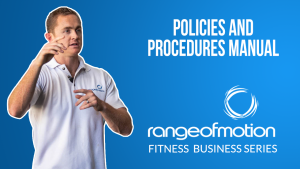8. Policies and Procedures Manual, Range of Motion Fitness Business Series
 In the previous three parts of this series, we’ve covered how to identify the roles in your business, how to assign tasks to each role, and how to systemise these tasks.
In the previous three parts of this series, we’ve covered how to identify the roles in your business, how to assign tasks to each role, and how to systemise these tasks.
This process has now effectively created an operations manual for you business – a document we work with Range of Motion Business Mentoring clients to create. Roles containing tasks containing systems. This single unifying document is the guide to how your business runs. You should be able to hand this document to someone else, and they should be able to run the majority of your business. In fact, this can be a good thought experiment. What percentage of your business could a stranger run if you were to hand them your policies and procedures manual? If the percentage is low, the detail and efficiency of your business systems needs to be improved. If the percentage is high, you’re well on the way to creating a business that exists to support a desired lifestyle. In too many cases, the opposite is true (a lifestyle is designed to support a business), and the long-term sustainability of the business is jeopardised.
The importance of a well systemised and clearly defined Policies and Procedures Document is four-fold:
- It allows you to simplify your business. All too often, as a business grows, it increases in complexity. This increase in complexity can leave a business owner feeling like they have ‘too many plates spinning’, and invariably, some plates will drop. A policies and procedures document, along with your mission statement will bring simplicity and order to your business.
- It acts as a resource for you to ensure you’re constantly working at maximum efficiency, and completing tasks in the most effective way.
- It provides a ‘how-to manual’ for future employees. Remember, the roles we identified in part five of this series are the first step in identifying the employees you should bring on board for your business as it grows. When your business does arrive at this point, your Policies and Procedures document allows for a seamless transition, and reduces the anxiety a business owner can often experience with delegation.
- It allows for long-term scalability of your business, and provides you with an ‘exit plan’. You’re not just building a business, you’re building an asset, and if you do ever decide to sell that asset, a comprehensive guide to how that business is run will dramatically increase that asset’s (your business’s) value.
It’s important to note that even if you never plan to expand to the point of bringing on outside employees (meaning points three and four above don’t apply), the enormous benefits your business will receive from just points one and two above still make this exercise worthwhile.
Your Policies and Procedures Manual should act as a stand-alone document. This will evolve over time, as your business grows and develops, and as you find more efficient ways to complete tasks. This document should be updated regularly (every quarter is a great place to start) to ensure it continues to reflect the true inner workings of your business.




